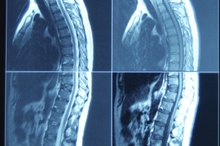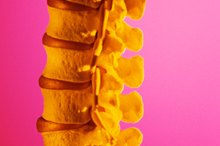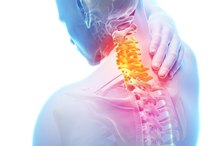What does fact checked mean?
At Healthfully, we strive to deliver objective content that is accurate and up-to-date. Our team periodically reviews articles in order to ensure content quality. The sources cited below consist of evidence from peer-reviewed journals, prominent medical organizations, academic associations, and government data.
The information contained on this site is for informational purposes only, and should not be used as a substitute for the advice of a professional health care provider. Please check with the appropriate physician regarding health questions and concerns. Although we strive to deliver accurate and up-to-date information, no guarantee to that effect is made.
Health Risks of Body Inverters
People use body inverters, or inversion tables, to facilitate a treatment technique known as inversion therapy, which is typically used to provide relief from back pain. Inversion is essentially a form of spinal traction that uses gravitational force to reduce compressive forces on the nerve roots and inter-vertebral discs. According to The Mayo Clinic, inversion therapy poses health risks for individuals with certain medical conditions, and potential users should always consult a physician before beginning to use an inverter.
If you are experiencing serious medical symptoms, seek emergency treatment immediately.
Fractures and Dislocations
Inversion therapy places excessive force on the bones and joints in an atypical manner. This can result in fractured or dislocated bones which can require medical care. Individuals with conditions such as osteoporosis, osteopenia, recent fractures or implants should definitely begin by discussing the therapy with their personal physicians.
Spinal Injury
Slant Board to Stretch Out Your Back
Learn More
Body inverters can help alleviate spinal pain via decompression of the vast complex of structures in the back. The Mayo Clinic states that inversion therapy can temporarily improve back pain associated with spinal disc compression in some individuals 1. However, such devices can actually cause a spinal injury or worsen a preexisting condition for certain patients.**
The Mayo Clinic also states that inversion therapy has not been proven to be particularly effective at providing long-term pain relief. Based on these findings, the benefit of pain relief may not outweigh the risks associated with inversion. If you suffer from a spinal condition or back pain, see your doctor prior to pursuing inversion therapy 1.
- Body inverters can help alleviate spinal pain via decompression of the vast complex of structures in the back.
- The Mayo Clinic states that inversion therapy can temporarily improve back pain associated with spinal disc compression in some individuals 1.
Eye Damage
As the body inverter progresses to a vertical position, there is an increase in ocular pressure. This can be extremely dangerous for individuals with certain pathologies of the eye. One specific condition that contraindicates the use of an inversion table is glaucoma. This condition is the result of increased pressure within the eyes and can lead to optical nerve damage and deterioration of vision. It is recommended that anyone with eye problems consult an ophthalmologist prior to using an inversion table.
- As the body inverter progresses to a vertical position, there is an increase in ocular pressure.
- This can be extremely dangerous for individuals with certain pathologies of the eye.
Hernias
Can an Inversion Table Help With Bulging Disks?
Learn More
Hernias occur when an organ in the body protrudes out of its containing wall or cavity. Using an inverter risks developing a hiatal hernia, which occurs as a result of increased intra-abdominal pressure. This increased pressure causes the stomach to protrude through a weak section of the diaphragm into the chest. Body inversion can also precipitate hernias in people with abdominal weakness.
Another common hernia is the ventral hernia which forms at the site of previous surgery. Individuals who have undergone recent surgery, have a history of hernia or have a weak core must consult a physician prior to inverting.
- Hernias occur when an organ in the body protrudes out of its containing wall or cavity.
- Using an inverter risks developing a hiatal hernia, which occurs as a result of increased intra-abdominal pressure.
Related Articles
References
- Mayo Foundation for Medical Education and Research: Does inversion therapy relieve back pain? Is it safe?
- EnergyCenter.com: Inversion Therapy Contraindications
- Wegner I, Widyahening IS, Van tulder MW, et al. Traction for low-back pain with or without sciatica. Cochrane Database Syst Rev. 2013;(8):CD003010. doi:10.1002/14651858.CD003010.pub5
- McMonnies CW. Intraocular pressure and glaucoma: Is physical exercise beneficial or a risk?. J Optom. 2016;9(3):139–147. doi:10.1016/j.optom.2015.12.001
- Chronic Back Pain. Health Policy Institute. https://hpi.georgetown.edu/backpain/. Published February 13, 2019.
- Kong L, Tian W, Cao P, Wang H, Zhang B, Shen Y. Predictive factors associated with neck pain in patients with cervical disc degeneration: A cross-sectional study focusing on Modic changes. Medicine (Baltimore). 2017;96(43):e8447. doi:10.1097/MD.0000000000008447
Writer Bio
Dr. Sam Vaid specializes in health, wellness, nutrition and sports performance. He is the president and CEO of Sci-Sport, a comprehensive health, wellness and sports performance organization. He is credentialed through the American College of Sports Medicine and holds a doctorate in physical therapy from the Medical College of Georgia.








